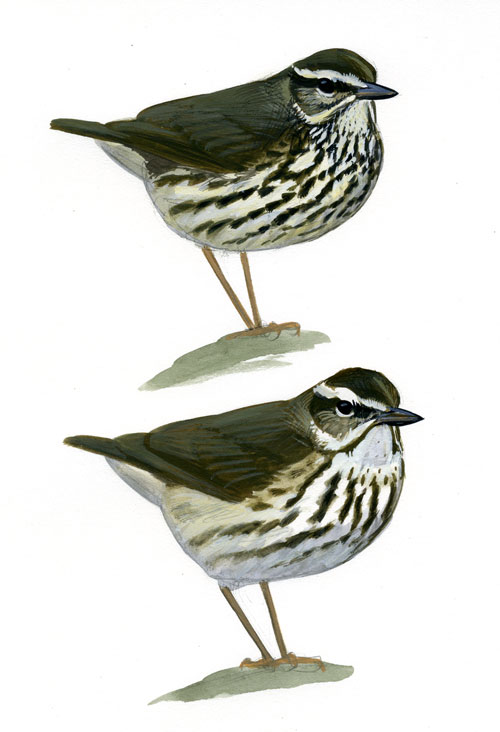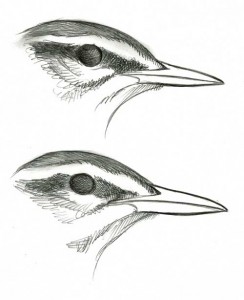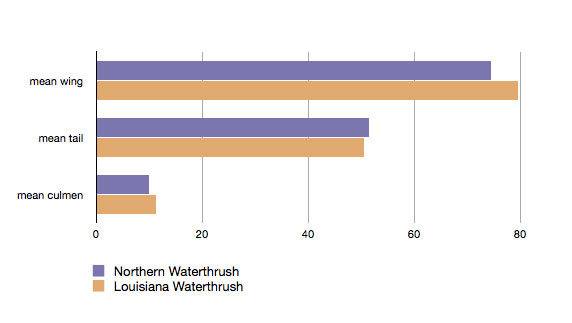
First Glance
A quick judgment of the ground color of the breast and eyebrow stripe will separate most waterthrushes: bright white on Louisiana, yellowish on Northern. A yellowish waterthrush is definitely a Northern, while a whitish bird could be either species. Next look at the shape of the eyebrow stripe, which broadens to the rear on Louisiana, and since it is also bright white on Louisiana this stripe can be very conspicuous (vs tapered behind the eye and usually yellowish on Northern).
The issue for identification is that a significant minority of Northerns appear bright white on those parts, and on those birds you must look for other details to confirm the identification. The converse (Louisiana appearing yellowish) never happens. Louisiana usually shows buff on the flanks, which can be fairly prominent. If that is the only part seen it could lead to an impression of yellowish underparts, but the breast, throat, and eyebrow are always clean white.
Louisiana vs Northern
- ground color of underparts always bright white (vs usually washed with pale yellow all over underparts, a small percentage of Northerns appearing white)
- eyebrow stripe broad and bright white at rear (vs narrower at rear and off-white or yellowish, only occasionally appearing bright white)
- bill averages longer and relatively thicker (vs shorter and thinner, appearing thin and pointed)
- flanks and undertail coverts often slightly buff (vs underparts yellowish to near white, with flanks and undertail coverts the same color as breast)

The buff (vs yellowish) flank color of Louisiana can be discernibly different, more useful is the fact that the flanks are colored while the breast is white (vs uniform color on Northern). Note that flank color of Louisiana is variable, obviously buff on some, nearly white on others, and tends to be paler when worn as in spring.
- breast streaking broader, brownish, appearing sparser (vs streaks smaller, darker, and appearing denser)
- streaking begins lower on breast, leaving upper edge of breast – just below throat – essentially unmarked (vs streaking begins on upper breast just below throat, and this forms necklace of smaller streaks)
There is variation in this, just as in throat spotting, but it will distinguiish most individuals and contributes strongly to the overall impression of a whiter and more sparsely-streaked breast on Louisiana.
- dark lateral throat stripe more solidly colored and paler brownish, not strongly connected to streaked area on upper breast (vs lateral throat stripe dark and distinct, formed of many tiny dark streaks, merging into small dark streaks on upper breast)
- breast streaks brownish like back, blending with brownish sides to create more uniform appearance (vs streaks blackish, darker than back and still visible against paler olive-brown breast sides)
- streaks on flanks fewer and less distinct; broader and smudgy, blending slightly with buff flanks, and only two lines of streaks present (vs streaks on flanks still dark and distinct as on breast, and three to four lines of streaks on flanks)
- belly largely unmarked white (vs belly with lines of very fine streaks convering from breast and flanks, leaving only a small area unmarked)
- pale rear malar wrapping around onto sides of neck is clear and unstreaked (vs a few fine dark streaks on sides of neck)
- pale arc below eye often less well-defined (vs contrasting more abruptly with dark lower auriculars)
- throat usually unspotted, clean white (vs usually finely speckled with dark)
Throat spotting separates many individuals (if it can be seen) but confirming this in the field is difficult, which creates a lot more effective overlap than when looking at birds in-hand. Some Northerns have only a few small spots at lower end of throat, some Louisianas have scattered small dots over throat.
- tail bobbing motion tends to be slower, more circular, with some side-to-side motion and with slower downstroke and quick upstroke (vs motion averages faster, more nervous, generally straight up and down with less side-to-side, and quicker downstroke with slower upstroke)
This is variable, and may be most useful when birds are perched and mildly agitated. Tail bobbing in both species is generally quicker when walking and foraging, slower when perched, and more extreme with a wider range of motion when strongly agitated. Kenn Kaufman (ID-Frontiers Feb 1997) reports that Louisiana when foraging can duplicate the quick downstroke motion of Northern, but he has not seen Northern duplicate the slow downstroke motion of Louisiana.
Very small differences
- supercilium slightly buff-gray at front above lores (vs supercilium more nearly uniform in color all the way to the bill)
- upperparts slightly browner or grayer (vs olive drab on Northern)
- in the hand note mostly white undertail coverts with limited and irregular pale gray centers that are concealed (vs more extensive, more regular, mostly concealed dark gray bases of undertail coverts)
- legs often brighter pink (vs darker grayish, dusky pink)
This is variable. Most Louisianas in fall have dusky leg color like Northern.
- overall larger and heavier, with rounded belly (vs sleek and tapered body)
- head may appear relatively smaller, with high forecrown and sloped rear crown (vs relatively larger head with smooth flat crown on Northern)
- relatively short tail
- lower auriculars average paler and smoother brownish, contrasting with broad brownish eyeline (vs lower auriculars dark grayish streaked, not contrasting as much with dark eyeline)
- dark eyeline averages broader and more brownish (vs narrow blackish line)
- Louisiana may tend to hold head higher above back (vs Northern tends to hold head lower)
- Crown stripes – a suggestion that Louisiana may show more of dark lateral crown stripes was firmly refuted (ID-Frontiers messages Feb 1997)
- bill color is the same in both species

Summary
Most waterthrushes are readily identified simply by the whiteness of the underparts. If you encounter a confusing individual pay special attention to the width of the eyebrow stripe, and the pattern and extent of streaking on the breast and flanks. Many other features, such as bill size, can offer supporting clues for experienced birders.


Great post, David!
You da man! The rest of us are just pedestrians.
Thank you for all your hard work.
what do you think about the difference in primary projection as posted by jochen roeder and charlie moores in 2007? see their blog:
http://belltowerbirding.blogspot.com.br/2007/05/separating-louisiana-and-northern_04.html
worked for me in a test of a single photo of an important new brazilian record. thanks for any comments.
Pingback: Louisiana Waterthrush – Chirp
I have photos and a short video of one of these waterthrushes (I think). I saw it at Wheeler Wildlife Refuge in Decatur, Alabama. I wonder if you’d be interested in helping me with an id? It has a yellowish color at the base of its tail which you didn’t mention. It seems like a Louisiana in some ways and a Northern in others.